|
Tuesday, Sept. 17
- Breakfast: All-American breakfast
- Breakfast: bacon, egg and cheese bagel
- Ranch chicken breast sandwich
- Smart cuisine: pork piccata with lemon sauce
- Chicken curry
- California turkey panini
- Taco salad
- Minnesota chicken and rice soup
- Chef's choice soup
Wilson Hall Cafe menu
|
|
Wednesday, Sept. 18
Lunch
- Southern-style barbecue ribs
- Black-eyed pea salad
- Honey cornbread muffins
- Peach cobbler
Friday, Sept. 20
Dinner
Closed
Saturday, Sept. 21
- Vol-au-vents with mushroom duxelle
- Brandy-braised pork tenderloin
- Cauliflower gratin
- Green bean amandine
- Apple walnut cake with spiced cream
Chez Leon menu
Call x3524 to make your reservation.
|
|
Beam sent to Fermilab Test Beam Facility
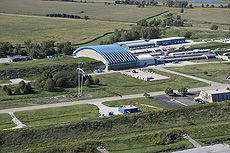 |
Since 2005, the Fermilab Test Beam Facility, with its distinctive blue, corrugated-steel roof, has staged more than 40 experiments, conducted by more than 500 collaborators from 23 countries.
Photo: Fred Ullrich
|
On Sunday evening, Sept. 15, beamline experts sent the first post-shutdown proton beam to the Fermilab Test Beam Facility. Last week experimenters had installed at the FTBF the test experiment T-1038, which comprises particle detector components to be installed in the PHENIX experiment at Brookhaven National Laboratory.
Four more test experiments will be installed at the FTBF this week. The facility is booked solid through July 2014, and FTBF coordinator Aria Soha has already received requests for the installation of test experiments in 2015. Whether experimenters need a few pions, muons or lots of protons, the FTBF can deliver. It is the only high-energy hadron test beam in the United States and serves as a proving ground for particle detector designs being developed for experiments at accelerator laboratories in the United States, Europe, Japan and throughout the world.
|
Two chances for green thumbs at Fermilab's Prairie Harvest on Oct. 5 and Nov. 2
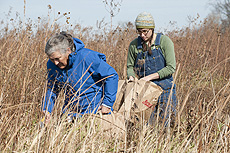 |
Fermilab's fall prairie seed harvests will take place on Oct. 5 and Nov. 2. Photo: Reidar Hahn
|
Calling all nature lovers. How would you like the chance to help diversify one of the oldest prairie restorations in Illinois?
The U.S. Department of Energy's Fermi National Accelerator Laboratory is looking for volunteers to help with its annual prairie seed harvest. Two harvest events are planned, on Saturday, Oct. 5, and Saturday, Nov. 2, beginning at 10 a.m. Fermilab's site hosts 1,000 acres of restored native prairie land, and each year community members pitch in to help collect seeds from those native plants.
Less than one-tenth of one percent of native prairies in Illinois remains intact. Fermilab's restored grassland is one of the largest prairies in the state. The deep-rooted natural grasses of the prairie help prevent erosion and preserve the area's aquifers.
The main collection area spans about 100 acres, and within it, volunteers will gather seeds from about 25 different types of native plants. Some of those seeds will be used to replenish the Fermilab prairies, filling in gaps where some species are more dominant than others.
"Our objective is to collect seeds from dozens of species," said Ryan Campbell, an ecologist at Fermilab. "We have more than 1,000 acres of restored grassland, and it's not all of the same quality. We want to spread diversity throughout the whole site."
Read more
|
Accelerator update, Sept. 16
Linac and Booster
AD personnel operated the Linac and Booster accelerators, tuned the machines and conducted machine studies.
Main Injector/NuMI
During the week of Sept. 9, the Main Injector provided 130 hours of proton beam to the NuMI target for the production of neutrinos for MINERvA, MINOS and NOvA. Accelerator experts conducted NuMI target scans and tuned the machine to increase the beam intensity in the Main Injector. The machine operated with a beam power of about 200 kilowatts and delivered an integrated intensity of 4.70 x 1018.
Recycler
On Friday, Sept. 13, AD personnel injected the first proton beam from the Booster into the reconfigured Recycler storage ring and succeeded in circulating the beam around the Recycler for about 30 turns.
Fixed-target area: Test Beam Facility
On Sunday evening, Sept. 15, AD personnel sent the first post-shutdown proton beam from the Main Injector to the Fermilab Test Beam Facility. Experiment T-1038 took data.
Fixed-target area: SeaQuest
Welders worked on flanges of the Neutrino Muon beamline berm pipe, which delivers beam to the SeaQuest experiment. Alignment personnel are mapping the berm pipe. First post-shutdown beam to SeaQuest is expected in October.
View the AD Operations Department schedule.
|
Superconductivity to meet humanity's greatest challenges
From the Institute of Physics, Sept. 16, 2013
The stage is now set for superconductivity to branch out and meet some of the biggest challenges facing humanity today.
This is according to a topical review "Superconductivity and the environment: a Roadmap", published [Sept. 16] in IOP Publishing's journal Superconductor Science and Technology, which explains how superconducting technologies can move out of laboratories and hospitals and address wider issues such as water purification, earthquake monitoring and the reduction of greenhouse gases.
Lance Cooley, a guest editor of the article who is based at the Fermi National Accelerator Laboratory, said: "Superconductivity has been meeting some great challenges over the past 50 years. The Large Hadron Collider, mankind's largest machine, would not exist were it not for superconductivity."
Read more
|
|
My first two weeks
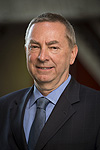 |
Fermilab Director
Nigel Lockyer
|
My goal over the last two weeks as the new director was to interact with as many members of the Fermilab staff and user community as possible. Many of you attended the seven "all hands" meetings, and I thank you for your helpful questions, comments and suggestions.
I spent much of the time getting to know the laboratory, from a weekend visit with the operators in the Main Control Room to a tour of the impressive Lederman Science Center. I am still talking about how our education program is a model that should be copied nationally as our nation strives to encourage young students to enter science and engineering careers. I toured Fermilab's Fire Department and met a dedicated team of professionals who stand prepared to assist the laboratory in times of need. (I didn't drive a fire engine … yet.) I also discovered the best espresso in the laboratory on the 11th floor of Wilson Hall. (Sorry CMS team for trashing your coffee quality index — I have learned my lesson about putting used coffee pods into the machine.)
I put my knowledge to good use when the Undersecretary for Science and Energy Michael Knotek visited last Wednesday. We toured the CMS control room and emphasized the huge 500-petabyte data storage capability of Fermilab, visited the superconducting accelerator facility and pointed out that particle physics is the steward of accelerators in the DOE Office of Science, discussed our plans to help industry with the development of products and services associated with accelerators at IARC, and visited the MINOS cavern to view the NOvA near detector under construction.
Beyond getting to know the lab and its people, I have also kicked off efforts to prepare the lab for the upcoming meetings of the Particle Physics Project Prioritization Panel (P5). The first of several scientists' retreats will take place this Saturday at CDF. The focus will be on active discussions among the lab's scientific staff, with a goal of collective clarity about the areas we wish to emphasize to the P5 committee. By December we expect a P5 town hall meeting to take place in the Chicago area, and we should be prepared to present an affordable and compelling plan that supports the community's goals and keeps up the momentum gained at the Snowmass meeting.
It's been a busy and exciting first two weeks, and I look forward to a productive next few months as we come together as a laboratory to push forward on a focused effort to deliver outstanding science.
|
Andromeda Galaxy
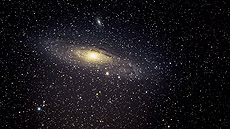 |
Marty Murphy took photos of the Andromeda Galaxy on Saturday morning. This picture comprises 108 individual 40-second exposures stacked and processed with special software, effectively creating the equivalent of a 70-minute exposure. Photo: Marty Murphy, AD |
|
Optical system installed in MicroBooNE detector
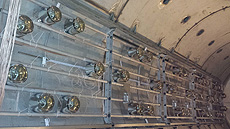 |
MicroBooNE's optical system, which captures and measures light resulting from particle interactions, was recently installed in the experiment's detector. Photo: Matt Toups, MIT
|
Members of the MicroBooNE experiment recently installed an optical system in the experiment's cryogenic vessel, currently located at DAB. When complete, the MicroBooNE cryogenic vessel will be filled with liquid argon.
When a neutrino — known for its unstoppability even as it passes through the densest substance — interacts with the liquid argon, the interaction will give birth to more particles, whose interactions in turn will produce light. The optical system will capture and measure this light, giving information about the timing of the neutrino interaction, as well as its position and energy.
Pictured here are the optical system's photomultiplier tubes, which will amplify the light signals for electronic readout in the liquid argon.
|
|